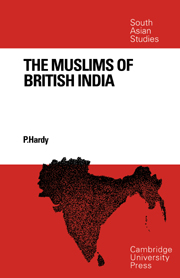Book contents
- Frontmatter
- Contents
- A note on spelling
- Acknowledgements
- 1 Introduction: the medieval legacy
- 2 The effects of British rule on Muslims before 1857
- 3 1857 and its aftermath
- 4 Muslims come to terms with British India as Muslims
- 5 Muslims move towards political community 1871–1901
- 6 Muslims acquire a constitutional identity and enter all-India politics
- 7 Religion enters politics 1910–24
- 8 The period of frustration 1924–35
- 9 The two partitions: of British India and of the Muslim community
- Maps
- A descriptive bibliography of works in European languages
- Glossary
- Index
1 - Introduction: the medieval legacy
Published online by Cambridge University Press: 19 October 2009
- Frontmatter
- Contents
- A note on spelling
- Acknowledgements
- 1 Introduction: the medieval legacy
- 2 The effects of British rule on Muslims before 1857
- 3 1857 and its aftermath
- 4 Muslims come to terms with British India as Muslims
- 5 Muslims move towards political community 1871–1901
- 6 Muslims acquire a constitutional identity and enter all-India politics
- 7 Religion enters politics 1910–24
- 8 The period of frustration 1924–35
- 9 The two partitions: of British India and of the Muslim community
- Maps
- A descriptive bibliography of works in European languages
- Glossary
- Index
Summary
Writing in November 1888, the Viceroy of India, Lord Dufferin (1826–1902), described the Muslims of British India as ‘a nation of 50 million, with their monotheism, their iconoclastic fanaticism, their animal sacrifices, their social equality and their remembrance of the days when, enthroned at Delhi, they reigned supreme from the Himalayas to Cape Cormorin’. Lord Dufferin's etching of his image of British India's Muslims is worth disinterring from the records of British rule in India because it expresses vividly the image of themselves which modern-educated Indian Muslims came to have in the later nineteenth and twentieth centuries. It was an image which spurred them to demand first a special political position in British India and then, in the nineteen-forties, independent statehood should the British leave. But it was an image which would have startled the Muslims of that earlier, pre-British, period when Muslims were supposed to have ‘reigned supreme from the Himalayas to Cape Cormorin’. Scattered unevenly over a subcontinent the size of western Europe, divided by sectarian beliefs, dietary habits and often by language, most under Muslim but some, as in the empire of Vijayanagar or in the coastal towns of the south, under non-Muslim rule, medieval Muslims did not think or act as a nation. As much subject as non-Muslim cultivators and weavers to domination by Mughal, Afghan and Turk, the Bengali Muslim cultivator or the Gujarati Muslim weaver was less engaged in a common enterprise of ruling India than members of the British working classes in the nineteenth century, for at least the latter were welcome as soldiers of the ruling power.
- Type
- Chapter
- Information
- The Muslims of British India , pp. 1 - 30Publisher: Cambridge University PressPrint publication year: 1972



